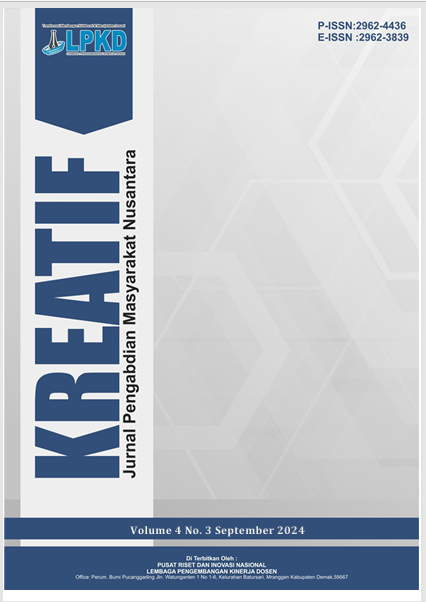Pendampingan Penyusunan Bahan Ajar Berbasis Digital bagi Guru di Sekolah Indonesia Kuala Lumpur Malaysia
DOI:
https://doi.org/10.55606/kreatif.v5i1.8451Keywords:
Digital, Educational technology, SIKL, Teacher, Teaching MaterialAbstract
In the digital technology era, schools are expected to be able to implement teaching materials through technology-based media to deliver learning content effectively. Therefore, the PKM team aims to assist teachers at Sekolah Indonesia Kuala Lumpur (SIKL) in developing technology-based teaching materials. The results of the training and mentoring sessions show that teachers are highly interested in the training on digital-based teaching materials. The teachers stated that the material presented during the training was clearly explained and easy to understand, particularly in the context of implementing online learning. The time required for the training activities was very efficient and effective, and the teachers found it to be much-needed. A total of 100% of the teachers agreed to use digital teaching materials after receiving the training. The conclusion of this community service is that the assistance provided aligns with the teachers' needs, as technology-based teaching materials are well-suited for both online and offline learning, enabling students to learn anytime and anywhere. The teachers' response to the teaching materials training was very positive. This program has had a significant impact on enhancing the teachers' understanding of developing digital teaching materials, which can contribute to improving the quality of education at Sekolah Indonesia Kuala Lumpur.
References
Aka, K. A. (2017). Pemanfaatan teknologi informasi dan komunikasi (TIK) sebagai wujud inovasi sumber belajar di sekolah dasar. ELSE (Elementary School Education Journal): Jurnal Pendidikan dan Pembelajaran Sekolah Dasar.
Arsal, M., Danial, M., & Hala, Y. (2019). Pengembangan media pembelajaran e-modul materi sistem peredaran darah pada kelas XI MIPA SMAN 6 Barru. https://doi.org/10.19109/bioilmi.v6i2.7011
Berthelsen, U. D., & Tannert, M. (2020). Utilizing the affordances of digital learning materials. L1-Educational Studies in Language and Literature, 20(2), 1-23. https://doi.org/10.17239/L1ESLL-2020.20.02.03
Diani, R., & Sri Hartati, N. (2018). Flipbook berbasis literasi Islam: Pengembangan media pembelajaran fisika dengan 3D pageflip professional. Jurnal Inovasi Pendidikan IPA, 4(2), 234-243. https://doi.org/10.21831/jipi.v4i2.20819
Divayana, D. G. H., Suyasa, P. W., & Adiarta, A. (2018). Pelatihan pembuatan buku digital berbasis KviSoft Flipbook Maker bagi para guru di SMK TI Udayana. Jurnal Abdimas Dewantara, 1.
Juniors, R., & Susilowibowo, J. (2020). Pengembangan bahan ajar e-book pada materi siklus akuntansi perusahaan jasa sebagai pendukung pembelajaran saintifik kelas X akuntansi di SMK Negeri 2 Tuban. Jurnal Pendidikan Akuntansi, 8(3), 2722-7502. https://doi.org/10.26740/jpak.v8n3.p55-59
Kasmiatang. (2017). Upaya peningkatan keaktifan dan hasil belajar peserta didik di kelas VII dengan penggunaan lembar kerja HOTS. Prosiding Seminar Nasional Biologi dan Pembelajarannya. https://en.wikipedia.org.
Kurt, S. (2019). Technology integration in education: A systematic review. Educational Technology Research and Development.
Mulyadi, D. U., Wahyuni, S., & Handayani, R. (2016). Pengembangan media flash flipbook untuk meningkatkan keterampilan berpikir kreatif siswa dalam pembelajaran IPA di SMP. Jurnal Pembelajaran Fisika, 4.
Rahmawati, D., Wahyuni, S., & Yushardi. (2017). Pengembangan media pembelajaran flipbook pada materi gerak benda di SMP. Jurnal Pembelajaran Fisika, 6.
Raja, R., & Nagasubramani, P. C. (2018). Impact of modern technology in education. Journal of Applied and Advanced Research. https://doi.org/10.21839/jaar.2018.v3iS1.165
Ramli, M. (2015). Media pembelajaran dalam perspektif Al-Qur'an dan Al-Hadits. Ittihad Jurnal Kopertais Wilayah XI Kalimantan, 13.
Thao Trinh Thi Phuong, Nguyen Tien-Trung, Nguyen Nam Danh, et al. (2023). Digital transformation in education: A bibliometric analysis using Scopus. European Science Editing, 49(e107138). https://doi.org/10.3897/ese.2023.e107138
Tsai, C.-C., & Chai, C. S. (2012). The 'third-order barrier' for technology-integration instruction: Implications for teacher education. Australasian Journal of Educational Technology. https://doi.org/10.14742/ajet.810
Widodo, A., & Riandi. (2013). Dual-mode teacher professional development: Challenges and re-visioning future TPD in Indonesia. Teacher Development, 17(3), 380-392. https://doi.org/10.1080/13664530.2013.813757
Zetriuslita, Z., Nofriyandi, N., & Istikomah, E. (2020). The effect of Geogebra-assisted direct instruction on students' self-efficacy and self-regulation. Infinity Journal, 9(1), 41. https://doi.org/10.22460/infinity.v9i1.p41-48
Downloads
Published
How to Cite
Issue
Section
License
Copyright (c) 2025 KREATIF: Jurnal Pengabdian Masyarakat Nusantara

This work is licensed under a Creative Commons Attribution-ShareAlike 4.0 International License.








